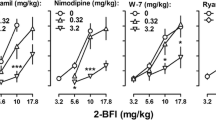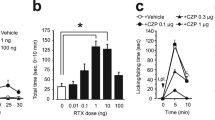Abstract
Rationale
Previous studies have shown that buspirone, a partial 5-HT1A receptor agonist, produces antinociceptive effects in rats and mice; Ca2+ plays a critical role as a second messenger in mediating nociceptive transmission. 5-HT1A receptors have been proven to be coupled functionally with various types of Ca2+ channels in neurons, including N-, P/Q-, T-, or L-type. It was of interest to investigate the involvement of extracellular/intracellular Ca2+ in buspirone-induced antinociception.
Objectives
To determine whether central serotonergic pathways participate in the antinociceptive processes of buspirone, and investigate the involvement of Ca2+ mechanisms, particularly L-voltage-gated Ca2+ channels and Ca2+/caffeine-sensitive pools, in buspirone-induced antinociception.
Methods
Antinociception was assessed using the hot-plate test (55°C, hind-paw licking latency) in mice treated with either buspirone (1.25–20 mg/kg i.p.) alone or the combination of buspirone and fluoxetine (2.5–10 mg/kg i.p.), 5-HTP (25 mg/kg i.p.), nimodipine (2.5–10 mg/kg i.p.), nifedipine (2.5–10 mg/kg i.p.), CaCl2 (25–200 nmol per mouse i.c.v.), EGTA (5–30 nmol per mouse i.c.v.), or ryanodine (0.25–2 nmol per mouse i.c.v.).
Results
Buspirone dose dependently increased the licking latency in the hot-plate test in mice. This effect of buspirone was enhanced by fluoxetine, 5-HTP, nimodipine, and nifedipine. Interestingly, central administration of Ca2+ reversed the antinociceptive effects of buspirone. In contrast to these, ryanodine or EGTA administered centrally potentiated buspirone-induced antinociception.
Conclusions
Decreasing neuronal Ca2+ levels potentiated buspirone-induced antinociception; conversely, increasing intracellular Ca2+ abolished the antinociceptive effects of buspirone. These results suggest that Ca2+ influx from extracellular fluid and release of Ca2+ from Ca2+/caffeine-sensitive microsomal pools may be involved in buspirone-induced antinociception.






Similar content being viewed by others
References
Bayliss DA, Li YW, Talley EM (1997) Effects of serotonin on caudal raphe neurons: inhibition of N- and P/Q-type calcium channels and the afterhyperpolarization. J Neurophysiol 77:1362–1374
Ben-Sreti MM, Gonzalez JP, Sewell RD (1983) Effects of elevated calcium and calcium antagonists on 6,7-benzomorphan-induced analgesia. Eur J Pharmacol 90:385–391
Berridge MJ (1998) Neuronal calcium signaling. Neuron 21:1326
Besson JM, Chaouch A (1987) Peripheral and spinal mechanisms of nociception. Physiol Rev 67:67–186
Cardenas CG, Del Mar LP, Scroggs RS (1995) Variation in serotonergic inhibition of calcium channel currents in four types of rat sensory neurons differentiated by membrane properties. J Neurophysiol 74:1870–1879
Chapman DB, Way EL (1982) Modification of endorphine/enkephalin analgesia and stress-induced analgesia by divalent cations, a cation chelator and an ionophore. Br J Pharmacol 75:389–396
Chen Y, Penington NJ (1996) Differential effects of protein kinase C activation on 5-HT1A receptor coupling to Ca2+ and K+ currents in rat serotonergic neurones. J Physiol 496:129–137
Crisp T, Stafinsky JL, Spanos LJ, Uram M, Perni VC, Donepudi HB (1991) Analgesic effects of serotonin and receptor-selective serotonin agonists in the rat spinal cord. Gen Pharmacol 22:247–251
Damaj MI (2000) The involvement of spinal Ca2+/calmodulin-protein kinase II in nicotine-induced antinociception in mice. Eur J Pharmacol 404:103–110
Daval G, Verge D, Basbaum A, Bourgoin S, Hamon M (1987) Autoradiographic evidence of serotonin 1 binding sites on primary afferent fibers in the dorsal horn of the rat spinal cord. Neurosci Lett 83:71–76
Del Mar LP, Cardenas CG, Scroggs RS (1994) Serotonin inhibits high-threshold Ca2+ channel currents in capsaicin-sensitive acutely isolated adult-rat DRG neurons. J Neurophysiol 72:2551–2554
Dogrul A, Yesilyurt O (1998) Effects of intrathecally administered aminoglycoside antibiotics, calcium-channel blockers, nickel and calcium on acetic acid-induced writhing test in mice. Gen Pharmacol 30:613–616
Dogrul A, Yesilyurt O, Isimer A, Guzeldemir ME (2001) L-type and T-type calcium channel blockade potentiate the analgesic effects of morphine and selective μ opioid agonist, but not to selective δ and κ agonist at the level of the spinal cord in mice. Pain 93:61–68
Eide PK, Joly NM, Hole K (1990) The role of spinal cord 5-HT1A and 5-HT1B receptors in the modulation of a spinal nociceptive reflex. Brain Res 536:195–200
El-Yassir N, Fleetwood-Walker SM (1990) A 5-HT1-type receptor mediates the antinociceptive effect of nucleus raphe magus stimulation in the rat. Brain Res 523:92–99
Friel DD, Tsien RW (1992) A caffeine- and ryanodine-sensitive Ca2+ store in bullfrog sympathetic neurons modulates effects of Ca2+ entry on [Ca2+]i. J Physiol 450:217246
Galeotti N, Ghelardini C, Bartolini A (1997) 5-HT1A agonists induce central cholinergic antinociception. Pharmacol Biochem Behav 57:835–841
Giordano J, Rogers L (1989) Antinociceptive effects of the novel anxiolytic buspirone in three pain tests in rats. Pain 39:109–113
Giordano J, Rogers L (1992) Putative mechanisms of buspirone-induced antinociception in the rat. Pain 50:365–372
Gobert A, Rivet JM, Cistarelli L, Melon C, Millan MJ (1999) Buspirone modulates basal and fluoxetine-stimulated dialysate levels of dopamine, noradrenaline and serotonin in the frontal cortex of freely moving rats: activation of serotonin1A receptors and blockade of α2-adrenergic receptors underlie its actions. Neuroscience 93:1251–1262
Haley TJ, McCormick WG (1957) Pharmacological effects produced by interacerebral injections of drugs in the conscious mouse. Br J Pharmacol 12:12–15
Hano K, Kaneto H, Kakunaga T (1964) Significance of Ca2+ ion in the morphine analgesia. Jpn J Pharmacol 14:227–229
Harris RA, Loh HH, Way EL (1975) Effects of divalent cations, cation chelators and an ionophore on morphine analgesia and tolerance. J Pharmcol Exp Ther 195:488–498
Jain NK, Kulkarni SK (1999) L-NAME, a nitric oxide synthase inhibitor, modulates cholinergic antinociception. Methods Find Exp Clin Pharmacol 21:161–165
Kakunaga T, Kaneto H, Hano K (1966) Pharmacologic studies on analgesics. VII. Significance of the calcium ion in morphine analgesia. J Pharmacol Exp Ther 153:134–141
Kitamura Y, Nagatani T, Watanabe T (1994) Buspirone enhances head twitch behavior in mice. Eur J Pharmacol 253:297–301
Koike H, Saito H, Matsuki N (1994) 5-HT1A receptor-mediated inhibition of N-type calcium current in acutely isolated ventromedial hypothalamic neuronal cells. Neurosci Res 19:161–166
Lin CH, Huang YC, Tsai JJ, Gean PW (2001) Modulation of voltage-dependent calcium currents by serotonin in acutely isolated rat amygdala neurons. Synapse 41:351–359
Lucas JJ, Mellstrom B, Colado MI, Naranjo JR (1993) Molecular mechanisms of pain: serotonin1A receptor agonists trigger transactivation by c-fos of the prodynorphin gene in spinal cord neurons. Neuron 10:599–611
Lucki I (1998) The spectrum of behaviors influenced by serotonin. Biol Psychiatry 44:151–162
Malmberg AB, Yaksh TL (1994) Voltage-sensitive calcium channels in spinal nociceptive processing: blockade of N-type and P-type channels inhibits formalin-induced nociception. J Neurosci 14:4882–4890
Malmberg AB, Yaksh TL (1995) Effect of continuous intrathecal infusion of ω-conopeptides, N-type calcium channel blockers, on behaviour and antinociception in the formalin and hot-plate tests in rats. Pain 60:83–90
McPherson PS, Kim YK, Valdivia H, Knudson CM, Takekura H, Franzini-Armstrong C, Coronado R, Campbell KP (1991) The brain ryanodine receptor: caffeine-sensitive Ca2+ release channel. Neuron 7:1725
Millan MJ (1994) Serotonin and pain: evidence that activation of 5-HT1A receptors does not elicit antinociception against noxious thermal, mechanical and chemical stimuli in mice. Pain 58:45–61
Miranda HF, Paeile C (1990) Interaction between analgesics and calcium channel blockers. Gen Pharmacol 21:171–174
Miranda HF, Bustamante D, Kramer V, Pelissier T, Saavedra H, Paeile C, Fernandez E, Pinardi G (1992) Antinociceptive effects of Ca2+ channel blockers. Eur J Pharmacol 217:137–141
Omote K, Sonoda H, Kawamata M, Iwasaki H, Namiki A (1993) Potentiation of antinociceptive effects of morphine by calcium-channel blockers at the level of the spinal cord. Anesthesiology 79:746–752
Ormazabal MJ, Goicoechea C, Alfaro MJ, Sanchez E, Martin MI (1999) Study of mechanisms of calcitonin analgesia in mice: involvement of 5-HT3 receptors. Brain Res 845:130–138
Penington NJ, Fox AP (1995) Toxin-insensitive Ca2+ current in dorsal raphe neurons. J Neurosci 15:5719–5726
Penington NJ, Kelly JS (1990) Serotonin receptor activation reduces calcium current in an acutely dissociated adult central neuron. Neuron 4:751–758
Protais P, Lesourd M, Comoy E (1998) Similar pharmacological properties of 8-OH-DPAT and alnespirone (S 20499) at dopamine receptors: comparison with buspirone. Eur J Pharmacol 352:179–187
Reader TA, Ase AR, Le Marec N, Lalonde R (2000) Differential effects of l-trytophan and buspirone on biogenic amine contents and metabolism in Lurcher mice cerebellum. Neurosci Lett 280:171–174
Redrobe JP, Bourin M (1998) Dose-dependent influence of buspirone on the activities of selective serotonin reuptake inhibitors in the mouse forced swimming test. Psychopharmacology 138:198–206
Rhee JS, Ishibashi H, Akaike N (1996) Serotonin modulates high-voltage-activated Ca2+ channels in rat ventromedial hypothalamic neurons. Neuropharmacology 35:1093–1100
Roberts MH (1984) 5-Hydroxytryptamine and antinociception. Neuropharmacology 23:1529–1536
Robles LI, Barrios M, Del Pozo E, Dordal A, Baeyens JM (1996) Effects of K+ channel blockers and openers on antinociception induced by agonists of 5-HT1A receptors. Eur J Pharmacol 295:181–188
Rousseau E, Smith JS, Meissner G (1987) Ryanodine modifies conductance and gating behavior of single Ca2+ release channel. Am J Physiol 253:C364–C368
Saeki K, Obi I, Ogiku N, Hakamata Y, Matsumoto T (1998) Characterization of brain-type ryanodine receptor permanently expressed in Chinese hamster ovary cells. Life Sci 63:575–588
Smith FL, Stevens DL (1995) Calcium modulation of morphine analgesia: role of calcium channels and intracellular pool calcium. J Pharmacol Exp Ther 272:290–299
Strosznajder J, Chalimoniuk M, Samochocki M (1996) Activation of serotonergic 5-HT1A receptor reduces Ca2+- and glutamatergic receptor-evoked arachidonic acid and No/cGMP release in adult hippocampus. Neurochem Int 28:439–444
Suh HW, Song DK, Choi SR, Huh SO, Kim YH (1997) Differential effects of ω-conotoxin GVIA, nimodipine, calmidazolium and KN-62 injected intrathecally on the antinociception induced by β-endorphine, morphine and [D-Ala2, N-MePhe4, Gly-ol5]-enkephalin administered intracerebro-ventricularly in the mouse. J Pharmacol Exp Ther 282:961–966
Sun QQ, Dale N (1997) Serotonergic inhibition of the T-type and high voltage-activated Ca2+ currents in the primary sensory neurons of Xenopus larvae. J Neurosci 17:6839–6849
Sun QQ, Dale N (1998) Differential inhibition of N and P/Q Ca2+ currents by 5-HT1A and 5-HT1D receptors in spinal neurons of Xenopus larvae. J Physiol 510:103–120
Uphouse L (1997) Multiple serotonin receptors: too many, not enough, or just the right number? Neurosci Biobehav Rev 21:679–698
Vocci FJ, Welch SP, Dewey WL (1980) Differential effects of divalent cation, cation chelators and an ionophore(A23187) on morphine and dibutyryl guanosine 3', 5'-cyclic monophosphate antinociception. J Pharmacol Exp Ther 214:463–466
Wang JF, Han SP, Lu Z, Wang XJ, Han JS, Ren MF (1989) Effect of calcium ion on analgesia of opioid peptides. Int J Neurosci 47:279–285
Wang XP, Liang JH, Lu Y, Zhang Q, Liu RK, Ye XF, Li LJ (2002) Anti-aggressive action of imipramine and buspirone in isolated mice. Chin J Psychiatry 35:28–31
Warner R, Hudson-Howard L, Johnston C, Skolnick M (1990) Serotonin involvement in analgesia induced by transcranial electrostimulation. Life Sci 46:1131–1138
Wei ZY, Karim F, Roerig SC (1996) Spinal morphine/clonidine antinociceptive synergism: involvement of G proteins and N-type voltage-dependent calcium channels. J Pharmacol Exp Ther 278:1392–1407
Williams S, Serafin M, Muhlethaler M, Bernheim L (1998) The serotonin inhibition of high-voltage-activated calcium currents is relieved by action potential-like depolarizations in dissociated cholinergic nucleus basalis neurons of the guinea-pig. Eur J Neurosci 10:3291–3294
Wong CH, Wu WH, Zbuzek VK (1998) Hypotension does not alter the antinociceptive effect of nifedipine. Life Sci 63:343–348
Xu W, Qiu XC, Han JS (1994) Serotonin receptor subtypes in spinal antinociception in the rat. J Pharmacol Exp Ther 269:1182–1189
Zemlan FP, Murphy AZ, Behbehani MM (1994) 5-HT1A receptors mediate the effect of the bulbospinal serotonin system on spinal dorsal horn nociceptive neurons. Pharmacology 48:1–10
Acknowledgements
We thank Dr. Mogens Nielsen (Royal School of Pharmacy, Universitetsparken 2, Denmark) and Dr. Hanting Zhang (University of Tennessee Health Science Center, USA) for their advice and assistance.
Author information
Authors and Affiliations
Corresponding author
Rights and permissions
About this article
Cite this article
Liang, JH., Wang, XH., Liu, RK. et al. Buspirone-induced antinociception is mediated by l-type calcium channels and calcium/caffeine-sensitive pools in mice. Psychopharmacology 166, 276–283 (2003). https://doi.org/10.1007/s00213-002-1327-4
Received:
Accepted:
Published:
Issue Date:
DOI: https://doi.org/10.1007/s00213-002-1327-4




